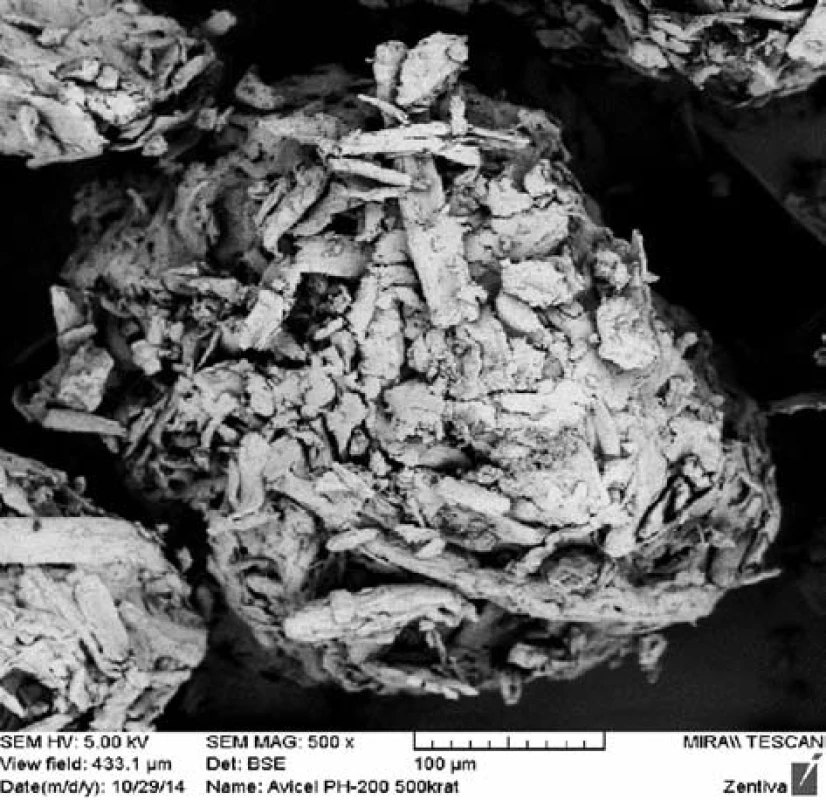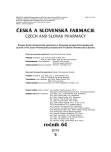-
Medical journals
- Career
Evaluation of the influence of lubricants on the viscoelastic properties of tablets using the stress relaxation test
Authors: Petra Svačinová; Pavel Ondrejček; Jan Stoniš; Johana Jirásková; Miloslava Rabišková; Zdenka Šklubalová
Authors‘ workplace: Charles University in Prague, Faculty of Pharmacy in Hradec Králové, Department of Pharmaceutical Technology, Czech Republic
Published in: Čes. slov. Farm., 2015; 64, 199-201
Category:
Introduction
Tablets are the most common dosage form. They are prepared by compression of powders or granular powders. The principle of the tablet compression process is the transformation of the undeformed particles of a compressed material to the elastically and plastically deformed particles due to the action of the compression force. The viscoelastic properties of the fillers and the impact of the lubricants on these properties are important factors, which are further reflected in the properties of tablets. A more detailed description of the viscoelastic properties and the interactions between the filler particles or the filler and the lubricants facilitate the selection of excipients for the tablet preparation to obtain tablets of required properties and quality.
This study evaluates the elasticity and plasticity behaviour of the tablet mixtures during the compression process. The influence of two different lubricants on microcrystalline cellulose, a filler intended for direct compression, is studied using the stress relaxation test.
Experimental methods
Materials
Microcrystalline cellulose Avicel PH-200 (MCC) was used as the filler. Magnesium stearate (MgSt) and/or modified colloidal silicon dioxide Syloid FP 244 EU (Syl), respectively, were used as lubricants at the concentration of 1%.
Methods
The particles were observed by a scanning electron microscope MIRATESCAN. The particle size distribution was measured by laser diffraction using a Malvern Mastersizer. Mixtures of the filler and the lubricants were prepared using a cube blender Erweka (AR 401 and KB 15S). A material testing machine Zwick/Roell T1 FRO 50 was used to compress the tablets having a mass of 500 ± 0.5 mg and a diameter of 13 mm using a compression pressure of 75.3 MPa. The tensile strength was calculated according to Fell and Newton1).
The stress relaxation test
The stress relaxation test was used to evaluate the parameters of elasticity Ai and the parameters of plasticity Pi of tablets. At the same applied compression pressure as mentioned above, the stress relaxation test was realized with a dwell time of 180 seconds. The following three-parametric equation [1] was used to calculate the elasticity parameters Ai. To calculate the plasticity parameters Pi, equation [2] was used2):
where CP is the compression pressure (MPa) at the time t (s), A1–3 represent the pressure decrease which expresses the elasticity parameter (MPa), A0 is the pressure remaining in a tablet after the dwell time (MPa), T1–3 are the relaxation constants (s), and P1–3 is the plasticity (MPa ⋅ s). The average of twenty measurements with the standard deviation are listed in Tables 1 and 2.
1. Parameters of elasticity Ai 
MCC – Avicel PH-200, MgSt – magnesium stearate, Syl – Syloid, Ai – elasticity parameters, x – average, s – standard deviation 2. Parameters of plasticity Pi 
MCC – Avicel PH-200, MgSt – magnesium stearate, Syl – Syloid, Pi – plasticity parameters, x – average, s – standard deviation Results and discussion
As can be seen in Figure 1, the particles of Avicel are of an irregular shape with a rough surface. The particle size was estimated by laser diffraction as follows: Dv10 = 31.88 μm, DV50 = 160.22 μm, and DV90 = 250.14 μm. Similarly, the particle size of magnesium stearate and Syloid were also measured having Dv10 = 2.63 μm, DV50 = 9.45 μm, and DV 90 = 29.82 μm and/or Dv10 = 1.87 μm, DV50 = 3.52 μm, and DV90= 7.43 μm, respectively. The smaller particles were noted for Syloid.
1. SEM image of Avicel PH-200 particle, magnification 500× 
In the stress relaxation test, the elasticity parameters A1–3 (MPa) express the interactions between the particles in the different phases of deformation3). A1 characterizes the interactions between the elastically deformed particles and the undeformed particles while A2 characterizes the interaction between the elastically and plastically deformed particles. The most important process for the plasticity evaluation and tablet formation is characterized by the parameters A3 and P3. At this process, generally, the elastically deformed particles act on each other in a material. It is assumed that the more bonds between particles are created during this particle action, the more the tablet structure firms up.
The values of elasticity parameters A1–3 are summarized in Table 1. The results show that an addition of a lubricant affects the elasticity parameters. Both lubricants increased the values of parameters A1, A2 and A3; the higher values were noted for Syloid. Avicel is considered as a viscoelastic material which can create strong bonds between the particles4, 5) and it shows a high potential for elastic deformation6). The Avicel particles can release the accumulated elastic energy which affects the other particles leading subsequently to a higher plasticity.
The lubricants create a thin layer on the surface of particles of the filler, fill the irregularities and prevent their interactions7). The less bonds are created between the particles, the more elasticity could be released and could affect other particles.
The values of plasticity parameters P1–3 (MPa·s) are shown in Table 2. These parameters express the plasticity which is formed as a result of the action of the elastically deformed particles and reflect to the creation of interparticle bonds. The increase in plasticity is visible from the two orders difference between the parameter P1 and P3 for MCC in Table 2. When the elastically deformed particles of viscoelastic material become plastically deformed, the hydrogen bonds can be created8) and the structure of the tablet completes.
Magnesium stearate and Syloid increase the values of plasticity parameters. Again, the higher values were determined for Syloid, probably for its smaller particles which are in better contact with the particles of a filler.
The results of the tensile strength measurement of the tablets can be seen in Table 3. It is visible that both lubricants decreased the tensile strength in comparison with the tablets made of MCC itself. A less negative effect, however, was found for Syloid. The differences in the lubricant effect can be caused by the structure and particle properties of the filler as well as by different properties of the lubricants. As explained above, the lubricants create a thin layer on the surface of particles, decrease the interactions between the filler particles reducing this way the tensile strength. Syloid as a hydrophilic lubricant has a lower effect on the particle interactions. In opposite, magnesium stearate is a hydrophobic lubricant which can prevent the interactions and reduce the tensile strength to a greater extent.
3. Tensile strength of tablets 
MCC – Avicel PH-200, MgSt – magnesium stearate, Syl – Syloid, TS – tensile strength, x – average, s – standard deviation Conclusions
In this work, the effect of magnesium stearate and/or modified colloidal silicon dioxide, respectively, on the elasticity and plasticity of microcrystalline cellulose is investigated. Different effects of lubricants on viscoelastic properties of this filler were observed. Hydrophilic Syloid increases the elasticity and the plasticity parameters of microcrystalline cellulose tablets more than magnesium stearate. On the other hand, Syloid had a less negative effect on the tensile strength of tablets. This is probably caused by its small particle size, hydrophilicity and viscoelastic properties. The exact explanation of the Syloid influence, however, requires further experiments.
This study was supported by SVV 260 183.
Conflicts of interest: none.
Mgr. Petra Svačinová
Charles University, Faculty of Pharmacy
Heyrovaského 1203, 500 05 Hradec Králové, Czech Republic
e-mail: svacp3aa@faf.cuni.cz
Sources
1. Fell J. T., Newton J. M. Determination of tablet strength by the diametral-compression test. J. Pharm. Sci. 1970; 59, 688–691.
2. Svačinová P., Řehula M., Ondrejček P., Rabišková M. Porovnání dvou metod charakterizujících proces lisování tablet. Chem. Listy 2014; 108, 624–629.
3. Řehula M., Adámek R., Špaček V. Stress relaxation study of fillers for directly compressed tablets. Powder Technol. 2012; 217, 510–515.
4. Newton J. M., Alderborn G., Nystrom C., Stanley P. The compressive to tensile-strength ratio of pharmaceutical compacts. Int. J. Pharm. 1993; 93, 249–251.
5. Govedarica B., Ilic I., Sibanc R., Dreu R., Srcic S. The use of single particle mechanical properties for predicting the compressibility of pharmaceutical materials. Powder Technol. 2012; 225, 43–51.
6. Shlieout G., Arnold K., Müller G. Powder and mechanical properties of microcrystalline cellulose with different degrees of polymerization. AAPS PharmSciTech 2002; 3, 45–54.
7. Zuurman K., Maarschalk K. V., Bolhuis G. K. Effect of magnesium stearate on bonding and porosity expansion of tablets produced from materials with different consolidation properties. Int. J. Pharm. 1999; 179, 107–115.
8. Matthews J. F., Skopec C. E., Mason P. E., Zuccato P., Torget R. W., Sugiyama J., Himmel M. E., Brady J. W. Computer simulation studies of microcrystalline cellulose Iβ. Carbohydr. Res. 2006; 341, 138–152.
Labels
Pharmacy Clinical pharmacology
Article was published inCzech and Slovak Pharmacy

2015 Issue 5-
All articles in this issue
- Methods used in pharmaceutical technology to increase bioavailability of poorly soluble drugs after oral administration
- Level and factors influencing the patients’ satisfaction with the pharmaceutical care in Slovakia
- Drugs and health care expenditure on the aging population
- Drug bioavailability increasing by formulation of liquisolid systems
- Evaluation of compressibility of tableting mixtures using the compaction equation
- Branched polyesters as mucoadhesive carriers of drugs
- Evaluation of water absorption rate of tablets by using an Enslin-Neff device
- Evaluation of the influence of lubricants on the viscoelastic properties of tablets using the stress relaxation test
-
44th Conference drug synthesis and analysis
(Brno, 2nd to 4th September 2015) – Part 1 - Determination of biologically active compounds in the fungi of the genus Cordyceps sinensis by HPLC and NMR
- Determination of CMC of cationic tenside in aqueous and mixed water-alcohol solutions
- A comparison of SiO2-, Cu-, and Ni-supported Au nanoparticles for selective glycerol oxidation to acetic acid*
- Determination of acid-base dissociation constants of newly synthesized arylethanolamine derivatives using capillary zone electrophoresis
- HPLC method for stability evaluation of pharmaceutical preparations containing sodium picosulfate
- The use of 2,6-dichloroquinone-4-chlorimide for quantitative determination of phenylephrine hydrochloride in combined tablets with paracetamol and chlorpheniramine maleate
- The utilization of radionuclide X-ray spectrometry in the determination of elements in medicinal plants and medicinal products used as antianemics
- On-line hyphenated capillary electrophoresis and tandem mass spectrometry used for the analysis of selected biogenic amines in grape leaves
- Validation of spectrophotometric methods of assaying metronidazole in capsules
- Czech and Slovak Pharmacy
- Journal archive
- Current issue
- Online only
- About the journal
Most read in this issue- Methods used in pharmaceutical technology to increase bioavailability of poorly soluble drugs after oral administration
- Level and factors influencing the patients’ satisfaction with the pharmaceutical care in Slovakia
- HPLC method for stability evaluation of pharmaceutical preparations containing sodium picosulfate
- The use of 2,6-dichloroquinone-4-chlorimide for quantitative determination of phenylephrine hydrochloride in combined tablets with paracetamol and chlorpheniramine maleate
Login#ADS_BOTTOM_SCRIPTS#Forgotten passwordEnter the email address that you registered with. We will send you instructions on how to set a new password.
- Career


